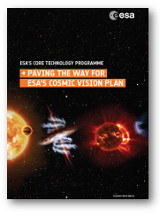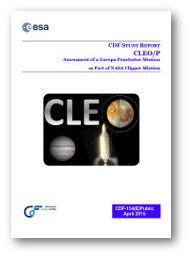ESA Science & Technology - Publication Archive
Publication archive
Publication archive
Aims. We derive for the first time the size-frequency distribution of boulders on a comet, 67P/Churyumov-Gerasimenko (67P), computed from the images taken by the Rosetta/OSIRIS imaging system. We highlight the possible physical processes that lead to these boulder size distributions.
Methods. We used images acquired by the OSIRIS Narrow Angle Camera, NAC, on 5 and 6 August 2014. The scale of these images (2.44−2.03 m/px) is such that boulders ≥7 m can be identified and manually extracted from the datasets with the software ArcGIS. We derived both global and localized size-frequency distributions. The three-pixel sampling detection, coupled with the favorable shadowing of the surface (observation phase angle ranging from 48° to 53°), enables unequivocally detecting boulders scattered all over the illuminated side of 67P.
Results. We identify 3546 boulders larger than 7 m on the imaged surface (36.4 km²), with a global number density of nearly 100/km² and a cumulative size-frequency distribution represented by a power-law with index of -3.6 +0.2/-0.3. The two lobes of 67P appear to have slightly different distributions, with an index of -3.5 +0.2/-0.3 for the main lobe (body) and -4.0 +0.3/-0.2 for the small lobe (head). The steeper distribution of the small lobe might be due to a more pervasive fracturing. The difference of the distribution for the connecting region (neck) is much more significant, with an index value of -2.2 +0.2/-0.2. We propose that the boulder field located in the neck area is the result of blocks falling from the contiguous Hathor cliff.
[Remainder of abstract truncated due to character limitations]
Context. Here we describe a new model of the dust streams of comet 67P/Churyumov-Gerasimenko that has been developed using the Interplanetary Meteoroid Environment for Exploration (IMEX). This is a new universal model for recently created cometary meteoroid streams in the inner solar system.
Aims. The model can be used to investigate characteristics of cometary trails: here we describe the model and apply it to the trail of comet 67P/Churyumov-Gerasimenko to develop our understanding of the trail and assess the reliability of the model.
Methods. Our IMEX model provides trajectories for a large number of dust particles released from ~400 short-period comets. We use this to generate optical depth profiles of the dust trail of comet 67P/Churyumov-Gerasimenko and compare these to Spitzer observations of the trail of this comet from 2004 and 2006.
Results. We find that our model can match the observed trails if we use very low ejection velocities, a differential size distribution index of α ≈ -3.7, and a dust production rate of 300–500 kg s-1 at perihelion. The trail is dominated by mm-sized particles and can contain a large proportion of dust produced before the most recent apparition. We demonstrate the strength of IMEX in providing time-resolved histories of meteoroid streams. We find that the passage of Mars through the stream in 2062 creates visible gaps. This indicates the utility of this model in providing insight into the dynamical evolution of streams and trails, as well as impact hazard assessment for spacecraft on interplanetary missions.
--- Remainder of abstract truncated due to character limitations ---
The deepest XMM-Newton mosaic map of the central 1°.5 of the Galaxy is presented, including a total of about 1.5 Ms of EPIC-pn cleaned exposures in the central 15 arcsec and about 200 ks outside. This compendium presents broad-band X-ray continuum maps, soft X-ray intensity maps, a decomposition into spectral components and a comparison of the X-ray maps with emission at other wavelengths. Newly discovered extended features, such as supernova remnants (SNRs), superbubbles and X-ray filaments are reported. We provide an atlas of extended features within ±1° of Sgr A*. We discover the presence of a coherent X-ray-emitting region peaking around G0.1−0.1 and surrounded by the ring of cold, mid-IR-emitting material known from previous work as the 'Radio Arc Bubble' and with the addition of the X-ray data now appears to be a candidate superbubble. Sgr A's bipolar lobes show sharp edges, suggesting that they could be the remnant, collimated by the circumnuclear disc, of an SN explosion that created the recently discovered magnetar, SGR J1745−2900. Soft X-ray features, most probably from SNRs, are observed to fill holes in the dust distribution, and to indicate a direct interaction between SN explosions and Galactic centre (GC) molecular clouds. We also discover warm plasma at high Galactic latitude, showing a sharp edge to its distribution that correlates with the location of known radio/mid-IR features such as the 'GC Lobe'. These features might be associated with an inhomogeneous hot 'atmosphere' over the GC, perhaps fed by continuous or episodic outflows of mass and energy from the GC region.
--- Remainder of abstract truncated due to character limitations ---
First published online 28 September 2015
The factors shaping cometary nuclei are still largely unknown, but could be the result of concurrent effects of evolutionary and primordial processes. The peculiar bilobed shape of comet 67P/Churyumov–Gerasimenko may be the result of the fusion of two objects that were once separate or the result of a localized excavation by outgassing at the interface between the two lobes. Here we report that the comet's major lobe is enveloped by a nearly continuous set of strata, up to 650 metres thick, which are independent of an analogous stratified envelope on the minor lobe. Gravity vectors computed for the two lobes separately are closer to perpendicular to the strata than those calculated for the entire nucleus and adjacent to the neck separating the two lobes. Therefore comet 67P/Churyumov–Gerasimenko is an accreted body of two distinct objects with 'onion-like' stratification, which formed before they merged. We conclude that gentle, low-velocity collisions occurred between two fully formed kilometre-sized cometesimals in the early stages of the Solar System. The notable structural similarities between the two lobes of comet 67P/Churyumov–Gerasimenko indicate that the early-forming cometesimals experienced similar primordial stratified accretion, even though they formed independently.Martian aurorae have been detected with the SPICAM instrument on board Mars Express both in the nadir and the limb viewing modes. In this study, we focus on three limb observations to quantify both the altitudes and the intensities of the auroral emissions. The CO (a³Π - X1Σ) Cameron bands between 190 and 270 nm, the CO (A1Π - X1Σ+) Fourth Positive system (CO 4P) between 135 and 170 nm, the CO2+ (B²Σu+ - X²Πg) doublet at 289 nm, the OI at 297.2 nm and the 130.4 nm OI triplet emissions have been identified in the spectra and in the time variations of the signals. The intensities of these auroral emissions have been quantified and the altitude of the strongest emission of the CO Cameron bands has been estimated to be 137±27 km. The locations of these auroral events have also been determined and correspond to the statistical boundary of open-closed magnetic field lines, in cusp-like structures. The observed altitudes of the auroral emissions are reproduced by a Monte-Carlo model of electron transport in the Martian thermosphere for mono-energetic electrons between 60 and 200 eV. No correlation between electron fluxes measured in the upper thermosphere and nadir auroral intensity has been found. Here, we simulate auroral emissions observed both at the limb and at the nadir using electron energy spectra simultaneously measured with the ASPERA-3/ELS instrument. The simulated altitudes are in very good agreement with the observations. We find that predicted vertically integrated intensities for the various auroral emissions are overestimated, probably as a consequence of the inclination and curvature of the magnetic field line threading the aurora. However, the relative brightness of the CO and CO2+ emissions is in good agreement with the observations.
This brochure acts as a guide to ESA's Core Technology Programme and how it supports the Cosmic Vision Plan – ESA's mechanism for the long-term planning of space science missions.
The information featured here describes how the science directorate ensures that the technology needed to make these ground-breaking missions a reality is ready when needed. It also outlines the work the Core Technology Programme has already done toward some of the most ambitious missions in ESA's history.
Document reference: CDF-154(E)
This document is the assessment study report for CLEP, the Clipper Europa ESA Penetrator mission, which could be a part of the NASA Clipper mission.
As the junior partner to the Clipper mission ESA are considering a potential mission of opportunity that could be considered by the science community in future mission proposals, to either carry out fly-bys of the Jupiter Moon Io — the subject of another study — or Europa, or possibly to impact Europa — the subject of this study.
The assignment was to formulate a penetrator concept, with high velocity impact on Europa and subsurface investigation, including a life detection experiment, for a possible ESA contribution to the NASA Clipper mission and to evaluate its feasibility. Full details are available in the report.
The report has been prepared by the ESA concurrent design facility.


